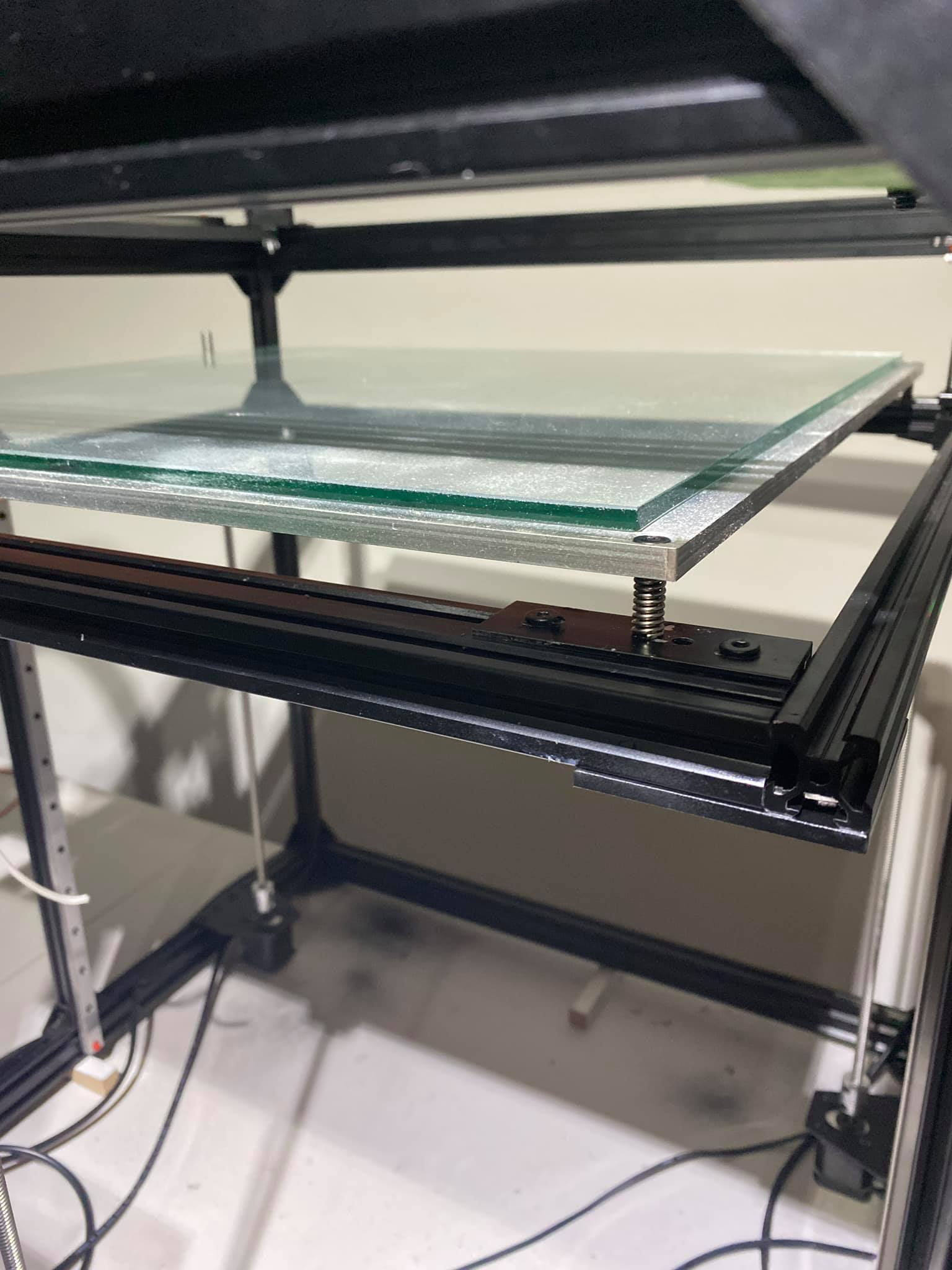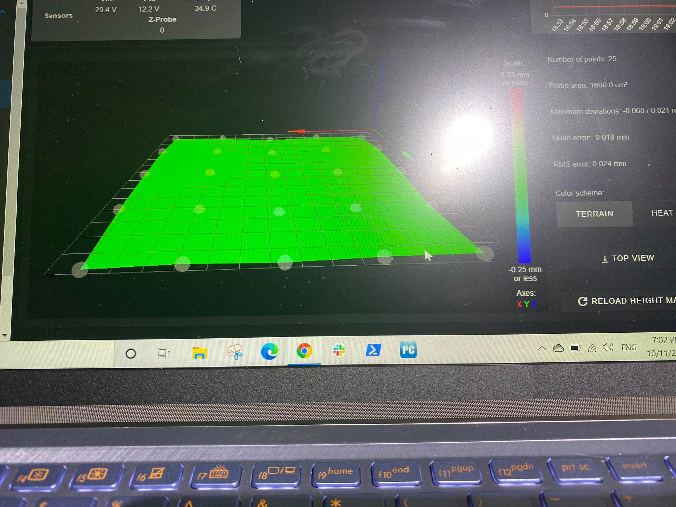Height Map - 500mmx500mmx4mm aluminium build plate
-
@achrn said in Height Map - 500mmx500mmx4mm aluminium build plate:
giving a total of 0.08953 (c.f. 0.07985).
Sorry, should be total of 0.12878 (i.e. 0.10889+0.01984) cf 0.07985.
-
I'll close out on this discussion, and thank everybody for the detailed input.
I've now got a 6mm glass plate so have been able to move on. Will start a new thread.
-
@achrn I can only say wow, and express my gratitude for the level of detail here. Much of it is immediately understandable to an amateur, as you describe the process, and facts needed to get to the results.
My aluminium play is indeed suspended on 4 springs/bolts at the corners. However, remember it also has a heater pad (~500x500) stuck to the back of it.
When I put a straight edge on the plate, I actually see "ripples" which I understand is not unusual for plate due to the rolling process.
Anyway, what is really interesting to me is that have placed a 500x500x6mm glass plate on top of the aluminium. I brought the plate up to 60, 70, then 80 degrees waiting around ten minutes each time to ensure the glass had time to come up to temperature too.
I was surprised by what I saw, which was the glass actually rocked around on the plate. I could get feeler gauges under almost the entire left side, which further indicated that glass is sat on a "hump" in the middle of the plate. So clearly this 4mm plate is pretty unfit for any purpose regarding a build plate.
Give your simulations and my observations, the plate appears to have issues arising from manufacturing process, and then deformations mostly due to self-weight then.
Thanks again, I learned a great deal from your response.
-
Have you considered getting a flat aluminum plate, specifically cast tooling plate, that comes milled flat? It is more likely to contact the glass everywhere and provide a uniform temperature over the surface of the glass.
-
@vistalert said in Height Map - 500mmx500mmx4mm aluminium build plate:
@achrn I can only say wow, and express my gratitude for the level of detail here. Much of it is immediately understandable to an amateur, as you describe the process, and facts needed to get to the results.
No problem - part of my living is made is explaining these sort of matters to barristers (and potentially judges) so lots of practice trying to make them intelligible. Also, I have the tools that make analyising a flat plate trivial. Normally I don't get to play with them myself - someone working for me does it. It does me no harm to prove to myself that I can still work the tools (even if only on a trivial case)!
-
@achrn very interesting. I'm working on a platform in Australia and New Zealand for online dispute resolution. 3D printing is for my hobby / personal projects. The whole ADR space is very exciting at the moment.
@mrehorstdmd I have considered that. It seems hard to source in Australia. I tried one supplier in Perth, but they told me their plate came off of a role, not cast. I will look into it, but it seems less critical if all it is doing is supporting the glass.
I'm not likely to ever take the glass off (unless it breaks) so that's why I was wondering if bonding the aluminium to the glass is a sensible idea. I put the glass on my granite worktop, apply whatever adhesive is appropriate, lay the aluminium on top and then load it up with bricks to hold it down. Is that a crazy idea?
-
@vistalert said in Height Map - 500mmx500mmx4mm aluminium build plate:
I'm not likely to ever take the glass off (unless it breaks) so that's why I was wondering if bonding the aluminium to the glass is a sensible idea. I put the glass on my granite worktop, apply whatever adhesive is appropriate, lay the aluminium on top and then load it up with bricks to hold it down. Is that a crazy idea?
It's the 'unless it breaks' that I'd be nervous of - I've cracked glass plate taking PETG off it. I'd be nervous of having bonded-on glass in case it happens again. (Of course, if you never make a mistake with your bonding / debonding layer, that won't happen - but I didn't think it would happen to me).
-
@achrn - Yes it seems "these things" have a higher incidence rate for some of us
 The conundrum is having a 6mm piece of glass, then the 500x500mm build area dictating a 7mm thick plate. That would give me a lot of mass to heat up. I do have a mains powered bed heater though.
The conundrum is having a 6mm piece of glass, then the 500x500mm build area dictating a 7mm thick plate. That would give me a lot of mass to heat up. I do have a mains powered bed heater though. -
Well one thing I hate about forums is when you see these big problems discussed, and advice and solutions offered, but then there's an abrupt stop in the conversation, and you never know what happened.
Several weeks ago, as you may have read here, I was really struggling with my supplied build plate, as it's 500x500 and only 4mm thick. Also, I struggled to find anybody in Western Australia, that could supply an aluminium plate that was guaranteed to be "flat", and when I enquired in Sydney, there were limited options for tool plate.
Long story short, thanks to the collective experience of everybody in this forum, I learned how I should go out and source a new plate, or at least, work with the constrains arising due to my location, and get a plate produced.
I found an engineering company here in Perth that could start with a 10mm plate, and machine it. Their advice was it would have to be machined on both sides, because of surface tension. Turns out, to get the plate "flat" it had to be machined 5 times. The resulting thickness was 7.7mm, which thanks to the advice above I know would mean there is minimum sag, due to own weight.
So I got the plate installed, and added my 6mm glass plate and finally got by bed mesh done.
I think it's safe to say the result is amazing.


I have a few more things todo before I can actually print, but I have my "shutdown" and "startup sequence", which puts me in a great place with consistent bed mesh results.
- I have mechanical endstops for X and Y, so my homing here is pretty accurate
- I use stalling on my Z axis, and send the plate to max-z until it touches the couplings. And I call this my "parked" position"
- I now have a macros that raises the bed 480mm from the parked position, then I home all. So X then Y then Z all home.
- When I execute G29 now, I get an amazing height map.
Now I have to say the bed has been an investment, but clearly a worthwhile one. The plate cost me $280 AUD. The glass was about $25.
I've been cautioned about my bolt mountings, where the plate rests on the springs/bolts. The concern being, will the aluminium expand when heated (of course it will, by about 0.7mm), so the question comes will the plate be able to expand with these bolts in place without being completely constrained, therefore warping. Some thoughts on this would be useful.
Largely though, my issues seem to all be resolved.
-
This post is deleted!